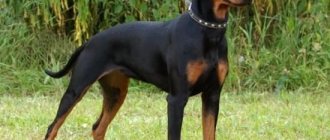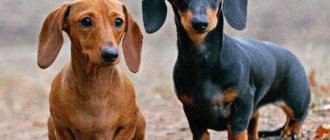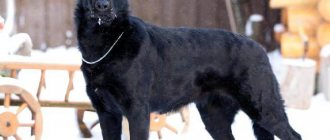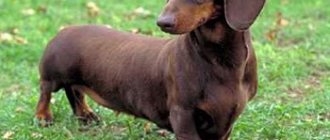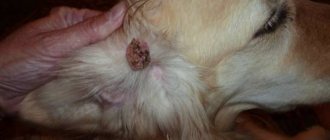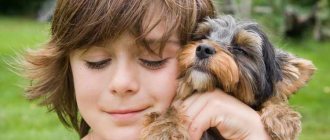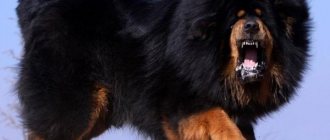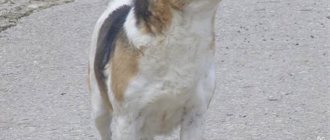The dachshund is both angel eyes and the character of a little devil. Despite its compact size, the dog of this breed is energetic and combative, which in no way prevents it from getting along well in a city apartment.
A dachshund can become a child’s best friend, a hunter, and a companion. The main thing is to take good care of her and welcome her excitement, playfulness and intelligence.
Briefly about the breed
The Dachshund is a short-legged, muscular and squat dog whose size is based on proportions. Thus, the body length of a thoroughbred animal should be 1.7 to 1 to its height, and the distance from the bottom of the chest to the support should be 1/3 of the height.
The standard type of dog is the largest and most versatile, used for burrow hunting and chasing large animals. Its dimensions are characterized by a height of about 35 cm, a sternum girth of more than 30 cm and a weight of up to 9 kg.
Miniature or dwarf dachshunds occupy a middle position, with a height and rib girth of up to 35 cm, and a weight of 3 to 4 kg. Dwarfs were bred from the stockiest animals of the standard species.
To obtain a more compact and nimble hound, the dog was crossed with pinschers and toy terriers and used in hunting hares and rabbits.
The standards also spell out body features: a wedge-shaped head, a flat, wide forehead and a flattened nose, oval eyes of dark brown and lightened shades, ears broken in the lower third, a long neck and a saber-shaped low tail.
Variegated and colorful
Dachshund dogs are divided not only by size, but also by coat type:
- Smooth-haired
- Longhair
- Wirehaired
The primary type of dachshund is smooth-haired, which is distinguished by short, shiny hair, very thick and close to the body. Long hair on the tail and feathering on the inside of the tail are acceptable.
The thick, fluffy cover on the face is especially pronounced, and the hair on the ears and tail, on the contrary, is short and smooth.
There are three types of color: one-color, two-color and spotted.
In the single-color version, all shades from fawn to chocolate are acceptable, and the more intense the color, the more thoroughbred the dog.
The two-tone color is a dark, black or brown coat with red or light tan.
The most popular dog names in alphabetical order with recommendationsShar Pei - history of the breed, character traits, care and possible problems + 87 photos
American Bulldog - history of the breed, appearance, specifics and characteristics, care (100 photos + video)
There are two types of dachshund spotting: marbled or brindle. In the first case, small light markings stand out on black, gray or red fur.
The brindle coloring resembles the skin of a predator: clear contrasting dark brown stripes on red-red or fawn fur.
What is a “tiger” and what is it eaten with?
The brindle color has existed in dachshunds since the founding of the breed! Those. since 1836, because The dachshund is an artificially bred breed, it is quite possible that one of the ancestors was a carrier of this color! And we must not forget that brindle color can only appear on a red background and not on any other! Those. either a brindle dog or a brindle tan dog. Unlike the merle, the tiger does not carry lethal genes and the mating of two brindle-colored dogs produces completely healthy puppies.
Brindle color is a dominant color that carries all colors (depending on what color the parents were) if the dog is heterozygous. If a dog is homozygous, then it does not carry any other color besides brindle. And when breeding such a dog with any other dog, the puppies will only be brindle. (We do not take marble). No one has ever bred dogs of brindle and coffee colors, but they have bred with red-nosed dogs. When mated to a coffee dog, again if the tiger does not carry the coffee gene (which is possible), the dogs will be red, black and brindle only they will all carry the coffee gene, but in this situation both parents are carriers of the tan gene at. And if only homozygous red ones are mated, you will never get puppies with brindle and tan.
Here are two examples of mating of a red and red brindle dog; phenotypically in both cases the parents look the same, but genetically:
in the first case, both parents carry the tan gene Ayat kk x Ayat kbr k =
puppies 1) Ayat kbr k - red brindle 2) Ayat kk - red 3) atat kbr k - black with brindle 4) atat kk - b/n
and the second, where both parents are homozygous for the A-locus
AyAy kk x AyAy kbr k =
puppies 1) AyAy kbr k – red brindle 2) AyAy kk – red
To get a brindle dog, one of the parents must be brindle.
The brindle gene draws BLACK stripes on all red colors, which is why black-brindle cats don’t have them on their bodies, well, you can’t see black on black! And the saturation of the color depends on the width of the stripes; where there are a lot of them, the dogs are very dark, where they are slightly, almost red. But coffee will have brown stripes. Also, a red dog with brown pigment and the brindle gene will be a regular brindle, but its stripes will not be black but brown. And if you add the fourth gene d, which some dachshunds also have, you can get red with gray or isabella brindles and gray and tan and isabella and tan with brindles on gray and isabella tans, respectively.
Taking care of your health
Dachshunds are genetically prone to diseases of the musculoskeletal system, so you need to carefully monitor your pet’s health.
An animal of this breed must have its own house or high bed to protect the dog from drafts. The activity of the dachshund requires a long daily walk, so it is necessary to stock up on special clothing for your pet to protect against dirt, rain and cold.
Otherwise, caring for a dachshund is no different from other dogs: bathe when dirty, periodically clean the ears, comb out the hair during shedding, regularly check the eyes and ears.
Marriage or breed?
The black and tan color is specified in the breed standard and is considered one of the most preferred. However, if the tan is very blackened and almost or completely merges with the main background, then this is considered a flaw.
If red hairs are completely absent, then such a dog is recognized as true black and is rejected from breeding..
“The black dachshund looks graceful and elegant. The bright red tan contrasts nicely with the main jet-black background of the coat and gives the dog a less severe appearance. However, in some dachshunds the tan may be too large, extending over the forehead and rising above the elbows and hocks, making the dog look atypical for its breed. In addition, these dogs also have very darkened tan, which is why the dachshund can look pure black.”
Optimal diet
A balanced diet plays an important role in maintaining a healthy dachshund. When creating a menu, it is necessary to take into account that dogs have a high need for microelements from early childhood, since they are genetically affected by “dwarfism.”
The optimal menu should consist of natural, fresh products. Be sure to consume dairy products, meat and grains.
- Newfoundland - history of the breed, education, care + 73 photos
Chihuahua - history of the breed, description, temperament, attitude towards people and animals, care + 92 photos
Brussels Griffon - history, modern appearance, standards, character and content + 77 photos
If you are an active and active person, then a dachshund will perfectly complement your company.
Fast and energetic, she cannot sit in one place for a long time, but is always ready to guard and protect her owner.
DAX
The most common diseases of dogs of this breed are related to the back. Dachshunds are prone to hind limb paralysis like no other breed and are always at risk of ending up in canine wheelchairs.
The length of the spine and short stature, combined with the activity of the dog, can cause intervertebral hernias and strangulation. Sometimes, with spinal injuries, the dog has problems with defecation. If your pet has difficulty walking, or if you find any indicators indicating back pain , contact your veterinarian immediately! Often timely surgical intervention can prevent loss of normal limb function. It is quite difficult to do physical exercises with a dachshund without putting much stress on the spine. As already mentioned, from a very early age it is advisable to install ramps in the apartment so that the dog does not jump on the sofa, but calmly walks onto it.
Like many other breeds, Dachshunds are prone to problems associated with bloating. First of all, the reason for this may be the excessive tendency of this breed to overeat. A completely healthy dog can suddenly feel unwell and even die. You should always carefully observe your pet's behavior. At the first sign of bloating, you should contact your veterinarian immediately.
Epilepsy, skin and eye diseases, even diabetes - all these diseases can affect the body of your beloved dachshund. There are cases when a dog becomes deaf due to a hereditary factor. Researchers have noticed that those dachshunds that were born from parents with a spotted coat are mostly prone to deafness.
One of the ways to obtain reliable information about possible genetic diseases of a dog is the so-called dog health registries. This is a great way to get information not only about the puppy's health, but also about the health of its parents. Dachshund health information may be included in the Canine Health Information Center database. For example, the Dachshund Club of America requires their owners to register the pet's health status in the Registry of Eye Diseases, and to have an appropriate health certificate from the Orthopedic Center.
A fairly good way to identify problems with retinal atrophy and a tendency to deafness is to conduct a DNA test. You should not trust those breeders who claim that such research is not necessary because their dogs are absolutely healthy!
Most people who breed dogs make every effort to ensure that their pets are healthy and beautiful. But Mother Nature is not always kind to everyone. Sometimes even the healthiest dogs get sick. When purchasing a little friend, ask the seller to provide information about the illnesses of the puppy’s parents, and if they died, be sure to find out the cause of death.
It should be noted that after the dachshund has entered your home, you can definitely protect your pet from one disease - from obesity. Maintaining a normal weight and preventing spinal injuries will be the key to a long and happy life for your dog. Remember that prevention is much easier than cure!
